Water/Wastewater
What Are the Sources of Micropollutants?
Jul 05 2022
Due to their persistent nature and the extreme difficulties involved in removing them from the environment, micropollutants have been concerning scientists and politicians for many years now. Although emitted into the world in very low concentrations, they have the ability to bioaccumulate over time and compromise air, soil and water quality, causing an imbalance in delicate ecosystems and jeopardising the health or even survival of the flora and fauna found therein.
Although organic micropollutants have been around for millennia and are a normal facet of the natural world, the increase in industrial and anthropogenic activity over the last two centuries has seen a significant rise in their concentrations in the atmosphere. So what exactly are these anthropogenic sources which are causing such an issue? Their almost omnipresent nature means it would be impossible to list all of them in an article such as this, but here’s an introduction to some of the most problematic.
Agriculture
Artificial products such as herbicides, pesticides and fertilisers are key to boosting crop yields and producing sufficient food for the global population. However, the chemicals contained in these products can seep into the soil and water surrounding farms, disrupting the delicate balance of nutrients and promoting the growth of some species to the detriment of others.
Industry
Industrial processes necessarily generate a significant amount of waste. Some of this can be recycled, but much of it is simply dumped into landfill, where the micropollutants (such as heavy metals, chemicals and polyaromatic hydrocarbons (PAHs)) in it can contaminate the natural world. Again, these can negatively impact the local wildlife if allowed to bioaccumulate.
Transport
While road, rail, sea and air transport are most commonly linked with air pollution, they’re also responsible for emitting micropollutants into the soil and water, too. Heavy metals, PAHs and damaging chemicals are contained within petrol and diesel, with spillages and accidents causing contamination of the surrounding area.
Sewage
Humans use products and processes which contain micropollutants on a daily basis. From the cosmetics we put on our skin and hair to the medication we take to cure ailments to even the food we consume, we’re in constant contact with these substances. Of course, the body does metabolise some of the ingredients, but the vast majority are allowed to wash down the drain to our sewers.
Wastewater treatment plants
Theoretically, the aforementioned sources would not be pose such a big issue if the pollutants could be filtrated out at the wastewater treatment stage. However, because we still know very little about many of these substances, most of the methods employed at wastewater treatment plants today are insufficient to deal with them. That means that the effluent discharge into the natural world is still packed full of them.
Digital Edition
IET 34.2 March 2024
April 2024
Gas Detection - Biogas batch fermentation system for laboratory use with automatic gas analysis in real time Water/Wastewater - Upcycling sensors for sustainable nature management - Prist...
View all digital editions
Events
Apr 30 2024 Melbourne, Australia
Apr 30 2024 Birmingham, UK
May 03 2024 Seoul, South Korea
May 05 2024 Seville, Spain
May 06 2024 Minneapolis, MN, USA


















